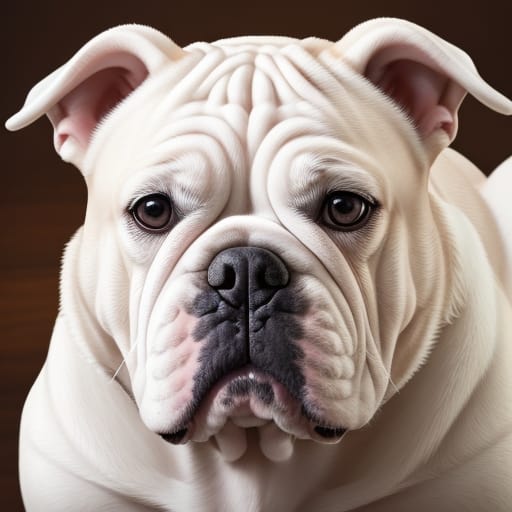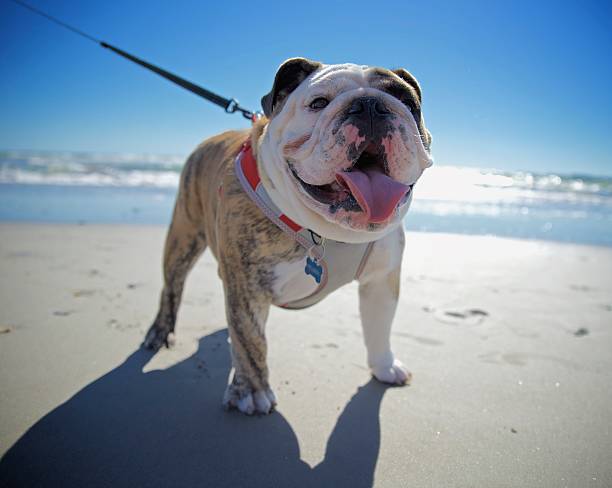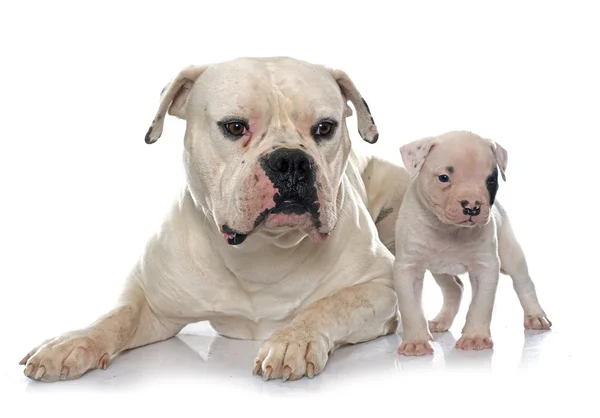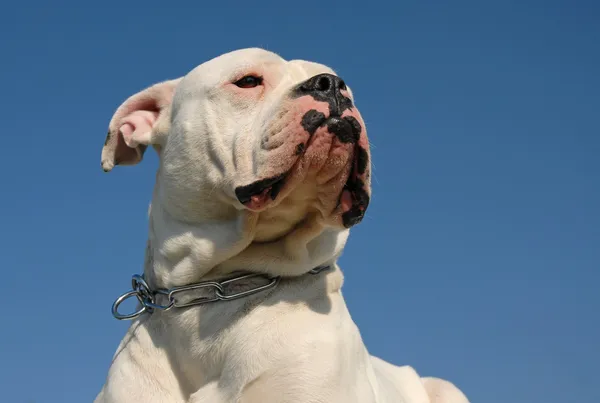The Scott Bulldog, also known as the Scott American Bulldog, is a captivating blend of strength, courage, and loyalty that resonates deeply with those who value determination and devotion. With its strong physique, courageous personality, and unyielding loyalty, this breed has firmly established itself as a cherished family member and a symbol of American canine spirit.

| Category (Explanation) | Breed Information |
|---|---|
| Year of Breed Conception | 20th century |
| Country of Origin | United States |
| Weight (Male) | 70-100 lbs (32-45 kg) |
| Weight (Female) | 60-80 lbs (27-36 kg) |
| Coat Type | Short, dense |
| Color Variations | White, brindle, or patchy |
| Shedding Level | Low to moderate |
| Height (cm & in) | 22-27 inches (56-69 cm) |
| Breed Size | Large |
| Trainability | Moderate |
| Mental Needs | Moderate |
| Intelligence Level | Moderate |
| Energy Level | Moderate to high |
| Agility | Moderate |
| Loyalty | High |
| Playfulness | Moderate to high |
| Exercise Needs | Regular exercise and play |
| Guarding Proficiency | Moderate |
| Sociability with Children | High |
| Barking Level | Low to moderate |
| Digging Tendency | Low to moderate |
| Destructive Behavior | Low to moderate |
| Drooling Level | Moderate to high |
| Obedience Level | Moderate |
| Apartment Friendly | Yes, with proper exercise and space |
| Inherent Prey Drive | Moderate |
| Physical Risk to Others | Low to moderate |
| Travel Fatality Risk | Low |
| Allergen Potential | Low (considered hypoallergenic) |
| Health Concerns | Hip dysplasia, joint issues |
| Average Life Expectancy | 10-13 years |










































































Woof Mastery is reader supported and our articles may contain affiliate links.
Instead of running third party ads that we have no control of we only use links from high-quality companies we are directly partnered with. Making use of these links come at no cost to you our reader, and in many cases have the extra benefit of discounted rates or sign up bonuses.
If you’re interested you can read more about our affiliate policy here.
We appreciate your support and always insure that the products and services we recommend are high-quality, helpful and relevant to the subject at hand!
The Scott Bulldog, also known as the Scott American Bulldog, has a history closely tied to the efforts of Alan Scott in the mid-20th century. Scott concentrated on the “standard” type of American Bulldog, emphasizing working ability and intelligence.
Through his dedication and careful breeding, the Scott Bulldog became a breed that excels in various tasks while retaining the American Bulldog’s distinctive appearance.
Today, Scott Bulldogs are celebrated for their versatility, intelligence, and unwavering loyalty. They stand as a testament to the enduring legacy of their founder, Alan Scott, and embody the spirit of American bulldogs as capable working dogs and devoted companions.

What sets the Scott Bulldog apart is its concentration on the “standard” type, prioritizing working ability and intelligence. These dogs are known for their keen intelligence and versatility. Scott Bulldogs balance their working abilities with an affectionate nature, making them a special breed for those who appreciate intelligence and companionship in one package.
Their traditional role was as working dogs on farms, displaying their athleticism and forming strong bonds with their families.
Scott Bulldogs are renowned for their loyal and protective personalities. They are known to be affectionate with their families and possess an innate intelligence that makes them responsive to training.
These dogs may have a formidable appearance, but they are gentle giants with those they love. Scott Bulldogs often have a calm and composed demeanor, which can be reassuring to their family members. They take their role as protectors seriously and are always watchful over their loved ones.
While they may initially approach strangers with caution, they quickly warm up to their families and display unwavering devotion. Scott Bulldogs represent a perfect balance of strength and affection in their character, providing both protection and companionship in equal measure.
Scott Bulldogs, or Scott American Bulldogs, are known for their affectionate and loyal temperament. While they may display protective instincts, they often form strong bonds with their families. Training and socialization are important to ensure these instincts are well-managed and do not escalate into overprotectiveness.
Territorial behavior and occasional stubbornness can be addressed with consistent and patient training methods. Leash training is vital due to their strength. Proper socialization often results in friendly interactions with other dogs and people, reflecting their well-adjusted and loving nature.
Scott Bulldogs, also known as Scott American Bulldogs, are medium to large-sized dogs known for their athletic and well-balanced build. They possess a square-shaped head with a well-defined jaw and muscular cheeks, contributing to their alert and friendly expression.
Their eyes are typically brown. Ears may be cropped or natural, depending on preference. These dogs feature a short, dense coat, often in shades of white with patches of brindle or other colors.
The coat accentuates their robust physique. Scott Bulldogs boast a muscular neck, leading to a broad chest and sturdy, straight legs. The tail is typically straight.
In terms of size, Males typically stand around 22 to 27 inches (56-69 cm) at the shoulder, and females are slightly smaller. Weight ranges from 80 to 110 pounds (36-50 kg) for males, with females being lighter.
Overall, Scott Bulldogs exhibit a robust and agile appearance, reflecting their history as versatile working and farm dogs. Their appearance exudes strength, agility, and a reliable disposition.
Scott Bulldogs, also known as Scott American Bulldogs, display a range of color variations that highlight their athleticism and strength. The most common color varieties include:
Scott Bulldogs, also known as Scott American Bulldogs, have a low shedding level. They are not known to be heavy shedders, and their shedding is generally minimal throughout the year. Occasional grooming and brushing with a soft bristle brush can help control shedding and keep their coat in good condition.
Factors that affect shedding in Scott Bulldogs are genetics and skin health. Properly managing skin care and addressing any dermatological issues can help minimize shedding. A balanced diet rich in essential nutrients is important for overall coat health and shedding control.
Scott American Bulldogs, with their harmonious blend of agility and strength, dons a coat that’s sleek and smooth to the touch.
Brushing: Despite the apparent ease of maintenance, their coat benefits from weekly brushing using a soft bristle brush, ensuring removal of loose hairs and stimulation of the skin. This ritual also offers an opportunity to check for ticks, fleas, or any skin abnormalities.
Bathing: Depending on their activities, a 5-7 week bathing routine is ideal. Those who venture outdoors might benefit from a bi-monthly bath, using shampoos tailored for sensitive skin.
Ears: Their ears, semi-floppy, can become a haven for dirt and moisture. Bi-weekly cleaning, combined with daily checks for any signs of redness, can ensure their auditory health.
Nails: Regular trimming, ideally every 10-14 days, is crucial. Their athletic nature can be hindered by overgrown nails.
Teeth: Their teeth, if neglected, can become a hub for tartar. A rigorous regime of brushing, combined with dental chews and professional cleanings, can be beneficial.
Wrinkle Care: Their delightful wrinkles, predominantly around the face, can trap food particles. Daily cleaning, followed by drying, is a must.
Eye Care: Their eyes often mirror their energetic persona. Any signs of cloudiness or unusual discharge should warrant a vet visit.
Scott Bulldogs, also known as Scott American Bulldogs, have a moderate activity level. They are known for their athletic and courageous nature. Here are some key points to consider about their activity level:
Scott Bulldogs, often referred to as Scott American Bulldogs, exhibit a moderate level of intelligence, marked by adaptability, problem-solving capabilities, and a strong inclination to please their owners. Here are key characteristics that highlight their intelligence:
While not as widely recognized as some other breeds, Scott Bulldogs possess intelligence evident in their trainability, problem-solving skills, and loyalty. They excel as both versatile companions and reliable watchdogs. Training, socialization, and mental stimulation are essential for them to reach their full potential.
Scott Bulldog, or the Scott American Bulldog, are eager learners and yearn for mind-engaging tasks. Present them with complex toys or agility exercises to cater to their keen intellect.
Social Interaction: Being family-oriented, they need frequent bonding sessions with their human counterparts. Neglect can trigger feelings of loneliness and anxiety.
Exercise: Physical activities are vital, not just for their robust build but also for their cognitive health. Activities like running or fetch can be both fun and beneficial.
Training and Obedience: Scott Bulldogs, given their intelligence, respond well to training sessions that challenge their minds and cement their bond with their caregivers. Positive methods yield the best results.
Routine and Structure: Predictable daily rhythms and structures provide them with a sense of safety and consistency, vital for their well-being.
Affection and Attention: Cuddling and spending quality moments with them is integral, given their affectionate and loyal nature.
Socialization: To ensure they grow into well-rounded adults, early exposure to different settings and creatures is pivotal.
Safe Environment: Providing them with a serene and secure space at home allows them moments of downtime and solitude.
Consistency: Regularity in training and daily life ensures they remain well-oriented and anchored in their environment.
Enter The Woof Mastery

Prior to bringing a Scott Bulldog (Scott American Bulldog) into your home, it’s important to understand their specific needs. These dogs are known for their athletic build and protective instincts. They require regular exercise and mental stimulation to maintain their well-being. Training and socialization are important to ensure they are well-behaved.
Be prepared for potential health concerns, including joint issues. Responsible ownership includes being prepared for grooming and providing a loving and secure environment for these loyal and vigilant companions.
Scott Bulldog or Scott American Bulldogs, another type of American Bulldog with a leaner build, have the potential to pose a physical danger if not adequately socialized, trained, or managed. Behavior is shaped by factors such as temperament, upbringing, training, and owner responsibility. Here’s their potential danger evaluation:
Scott Bulldogs are renowned for their loyal and protective personalities. They are known to be affectionate with their families and possess an innate intelligence that makes them responsive to training.
These dogs may have a formidable appearance, but they are gentle giants with those they love. Scott Bulldogs often have a calm and composed demeanor, which can be reassuring to their family members. They take their role as protectors seriously and are always watchful over their loved ones.
While they may initially approach strangers with caution, they quickly warm up to their families and display unwavering devotion. Scott Bulldogs represent a perfect balance of strength and affection in their character, providing both protection and companionship in equal measure.
Scott Bulldogs or Scott American Bulldogs, another line of the American Bulldog, possess their set of swimming traits. Here are some factors to ponder:
Scott Bulldogs, also recognized as Scott American Bulldogs, have a unique array of vocalizations they utilize for expression. Here’s what you might hear:
Scott Bulldog owners should understand their pet’s vocalizations and the reasons behind them. While many are purely expressive, others might signal specific needs or discomfort. Employing positive reinforcement can be beneficial in managing their vocal habits.
Scott Bulldogs, also known as Scott American Bulldogs, thrive in homes where they receive love, structure, and opportunities for socialization. Here are some ideal living conditions for Scott Bulldogs:
Challenges:
When it comes to travel fatality risk for Scott Bulldogs or Scott American Bulldogs, consider the following potential constraints:
Scott Bulldogs may be prone to specific health concerns. While not all individuals will experience these issues, it’s essential for Scott Bulldog owners to be aware of potential health problems and work with veterinarians to maintain their pets’ well-being. Common health concerns in Scott Bulldogs include:
Regular veterinary check-ups, a balanced diet, proper exercise, and responsible breeding practices can help mitigate some of these health concerns. It’s crucial for Scott Bulldog owners to work closely with their veterinarians to monitor their pets’ health and address any issues promptly.
Scott Bulldog (Scott American Bulldog): For Scott Bulldogs, also known as Scott American Bulldogs, maintaining proper nutrition is essential for their health and well-being. Here are tailored nutritional habits and best practices for this breed:
Breed-Specific Laws (BSL): Scott Bulldogs, often recognized as Scott American Bulldogs, may occasionally face breed-specific laws (BSL) in certain areas. Such laws differ across regions and are typically determined by local or city authorities.
Types of Restrictions: For Scott Bulldogs, BSL might involve mandatory spaying/neutering, distinct licensing, required liability insurance, muzzling provisions in public, and in some scenarios, bans on ownership, all based on local regulations.
Rationale for BSL: BSLs usually arise due to concerns over specific breeds and their potential risks, particularly in the event of incidents. Scott Bulldogs, known for their agility and determination, can sometimes be subjected to BSL due to their bulldog association.
Controversy: The topic of BSL remains controversial, with many arguing for a focus on individual dog behavior rather than breed-specific regulations. Many advocates push for responsible pet ownership and training.
Local Regulations: Those interested in Scott Bulldogs should consult local animal control or governmental bodies to ensure understanding and compliance with any breed-specific regulations.
Woof Mastery is reader supported and our articles may contain affiliate links.
Instead of running third party ads that we have no control of we only use links from high-quality companies we are directly partnered with. Making use of these links come at no cost to you our reader, and in many cases have the extra benefit of discounted rates or sign up bonuses.
If you’re interested you can read more about our affiliate policy here.
We appreciate your support and always insure that the products and services we recommend are high-quality, helpful and relevant to the subject at hand!
Myth 1: Scott Bulldogs (Scott American Bulldogs) are Aggressive by Nature
Myth 2: They are High-Energy Dogs
Myth 3: They Can’t Tolerate Cold Weather
Myth 4: They are Not Good with Children
Myth 5: They Shed Excessively
Myth 6: They Don’t Require Training
Myth 7: They are Always Good with Other Dogs
Myth 8: They Are All the Same Size
Myth 9: They are Unhealthy Dogs
Myth 10: They are Always Clingy
The Scott Bulldog (Scott American Bulldog) holds cultural significance in various contexts:
While there may not be as many famous Scott Bulldog owners as there are for other dog breeds, here are a few notable individuals who have been associated with Scott Bulldogs:
Scott Bulldogs, like many other dog breeds, have faced several threats and challenges over the years. Some of the significant threats and issues that have affected the breed include:
The Scott Bulldog is believed to have been developed from a combination of various breeds, with the primary ancestors being the original American Bulldogs and more agile working breeds. This type was primarily influenced by Allen Scott, thus the name. The specific breeds and strains that contributed to the Scott Bulldog’s development include:
Scott Bulldogs, also known as Scott American Bulldogs, are a harmonious blend of strength and charm, epitomizing the spirit of cherished family pets. With their muscular build and loving nature, they seamlessly integrate into our lives, providing not only security but also heartfelt devotion.
These dogs excel as watchdogs, displaying protective instincts that solidify their role as guardians of our homes. Scott Bulldogs are known for their adaptability, thriving in various living conditions, and requiring only minimal grooming. Their athletic prowess and playful spirit cater to active individuals and families, making them excellent playmates. Their intelligence shines in various activities and training.
Beyond their physical attributes, Scott Bulldogs bring a unique charm to every household, filling the air with their presence. Their versatility is a testament to their adaptability, transitioning effortlessly from beloved family pets to diligent working dogs.
Most importantly, Scott Bulldogs offer an unparalleled gift—profound and unconditional love. They become treasured family members, enriching our lives with their unwavering companionship and forging an unbreakable bond that lasts a lifetime. Embrace the incredible love and devotion that Scott Bulldogs have to share.